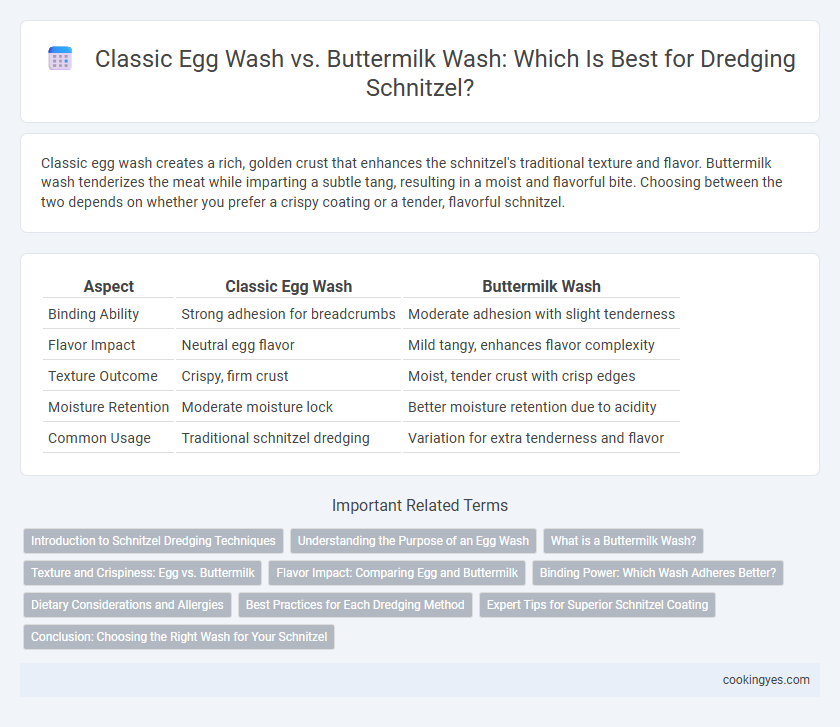Classic egg wash creates a rich, golden crust that enhances the schnitzel's traditional texture and flavor. Buttermilk wash tenderizes the meat while imparting a subtle tang, resulting in a moist and flavorful bite. Choosing between the two depends on whether you prefer a crispy coating or a tender, flavorful schnitzel.
Table of Comparison
| Aspect | Classic Egg Wash | Buttermilk Wash |
|---|---|---|
| Binding Ability | Strong adhesion for breadcrumbs | Moderate adhesion with slight tenderness |
| Flavor Impact | Neutral egg flavor | Mild tangy, enhances flavor complexity |
| Texture Outcome | Crispy, firm crust | Moist, tender crust with crisp edges |
| Moisture Retention | Moderate moisture lock | Better moisture retention due to acidity |
| Common Usage | Traditional schnitzel dredging | Variation for extra tenderness and flavor |
Introduction to Schnitzel Dredging Techniques
Classic egg wash creates a rich, adhesive coating that helps breadcrumbs firmly stick to schnitzel, resulting in a crispy, golden crust. Buttermilk wash, with its mild acidity, tenderizes the meat while providing a slightly tangy flavor and enhancing breadcrumb adherence. Both methods are essential in schnitzel dredging techniques, offering distinct textures and flavors that influence the final dish's quality.
Understanding the Purpose of an Egg Wash
An egg wash creates a sticky surface on schnitzel, allowing breadcrumbs to adhere evenly and form a crispy coating. Its proteins and fats contribute to browning and enhanced flavor during frying. Buttermilk wash, while adding tenderness and tanginess, lacks the binding strength of an egg wash essential for traditional schnitzel dredging.
What is a Buttermilk Wash?
A buttermilk wash is a tangy, creamy mixture used to coat schnitzel before dredging, enhancing flavor and tenderizing the meat. Unlike the classic egg wash, which relies on beaten eggs to help breadcrumbs adhere, buttermilk contains lactic acid that breaks down proteins, producing a juicier and more succulent schnitzel. This wash also creates a thicker, more robust crust when fried, resulting in a crispy and flavorful exterior.
Texture and Crispiness: Egg vs. Buttermilk
Egg wash creates a thicker, more uniform coating on schnitzel, resulting in a crispier and golden-brown crust ideal for traditional texture. Buttermilk wash tenderizes the meat while producing a lighter, less dense crust with a subtle tang, enhancing moisture retention but sacrificing some crispiness. Choosing between egg and buttermilk washes affects the schnitzel's balance of crunchy texture versus juicy tenderness in the final dish.
Flavor Impact: Comparing Egg and Buttermilk
Classic egg wash creates a rich, savory crust for schnitzel with a subtle eggy flavor that enhances the meat's natural taste. Buttermilk wash imparts a tangy acidity that tenderizes the meat and adds a slightly sharp complexity to the overall flavor profile. Choosing between egg and buttermilk wash influences the schnitzel's texture and depth, with egg providing a traditional, balanced crispiness and buttermilk delivering a tender, flavorful bite.
Binding Power: Which Wash Adheres Better?
A classic egg wash provides strong binding power for schnitzel dredging due to its protein-rich composition, which helps the breadcrumbs adhere firmly during frying. Buttermilk wash, while offering a tangy flavor and tenderizing effect, has a thinner consistency and lower protein content, resulting in slightly weaker adhesion compared to egg wash. For maximum breadcrumb adherence and a crisp, well-coated schnitzel, the classic egg wash remains the superior choice.
Dietary Considerations and Allergies
Classic egg wash for schnitzel dredging provides a rich binding layer but poses allergen concerns for individuals with egg allergies and those following vegan diets. Buttermilk wash offers a tangy flavor and tenderizing effect but contains dairy proteins, which can trigger lactose intolerance or milk allergies. For dietary restrictions, using alternative washes like plant-based milk or aquafaba can accommodate allergen sensitivities while maintaining texture and adhesion.
Best Practices for Each Dredging Method
Classic egg wash creates a thick, adhesive coating ideal for binding traditional breadcrumbs tightly to schnitzel, resulting in a crispy, golden crust. Buttermilk wash tenderizes the meat through its acidity while providing a slightly thinner coating that enhances adhesion for panko or seasoned crumbs, producing a lighter, airier texture. For best results, use chilled egg wash for thicker crusts and a well-seasoned buttermilk bath for moist, tender schnitzel with a delicate crust.
Expert Tips for Superior Schnitzel Coating
For superior schnitzel coating, classic egg wash provides a rich, sticky surface that helps breadcrumbs adhere evenly, creating a crisp, golden crust. Buttermilk wash tenderizes the meat with its mild acidity while offering a slightly tangy flavor and a thicker coating due to its viscosity. Experts recommend experimenting with buttermilk wash for added depth in flavor and moisture retention, especially when aiming for a juicier schnitzel.
Conclusion: Choosing the Right Wash for Your Schnitzel
A classic egg wash creates a rich, adhesive coating that helps breadcrumbs cling tightly, resulting in a crisp, golden-brown schnitzel. Buttermilk wash tenderizes the meat while adding a subtle tang, enhancing flavor and moisture retention during frying. Selecting between egg and buttermilk washes depends on whether you prioritize a traditional crunchy crust or a juicier, slightly tangy schnitzel texture.
Classic egg wash vs Buttermilk wash for schnitzel dredging Infographic

 cookingyes.com
cookingyes.com